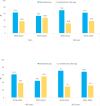Changes in prescription patterns of antidiabetic medication in patients newly diagnosed with type 2 diabetes in Spain: an observational study
- PMID: 40983582
- PMCID: PMC12458620
- DOI: 10.1136/bmjopen-2025-106069
Changes in prescription patterns of antidiabetic medication in patients newly diagnosed with type 2 diabetes in Spain: an observational study
Abstract
Objective: To estimate the frequency of antidiabetic prescriptions in type 2 diabetes mellitus (T2DM) in Spain and describe changes in prescription patterns between 2018-2022 and 2023-2024.
Design: Observational study.
Participants: Patients from primary care centres newly diagnosed with T2DM in 2018-2022 and 2023-2024.
Primary and secondary outcomes: In each period, the prescription frequency of an antidiabetic medication at the diagnosis of T2DM was calculated and subsequently subdivided into monotherapy and combination therapy. The prescription frequency of the most common antidiabetic drugs was also calculated. Calculations were made for the entire group of subjects and stratified by sex and age (under 60 years and 60 years or older). Comparison of the frequencies between the two periods was performed using the chi-square test.
Results: In 2018-2022 and 2023-2024, 78.4% and 88.9% of patients, respectively, were prescribed an antidiabetic medication. The prescription frequencies for monotherapy and combination therapy were 66.1% and 33.9% in the first period and 57.4% and 42.6% in the second. The prescription frequencies for metformin as monotherapy and combination therapy were 57.4% and 27.8% in the first period and 46.6% and 39.8% in the second. Prescribing metformin with sodium-glucose cotransporter-2 inhibitors (SGLT2i) and/or glucagon-like peptide receptor 1 agonists (GLP1a) was the most frequent combination therapy: 12.8% in 2018-2022 and 29.5% in 2023-2024. With a few exceptions, the prescribing pattern was similar by sex and age. The difference between the prescribing distributions in the two periods is significant.
Conclusion: Antidiabetic medication prescribing at the diagnosis of T2DM was high. Most prescriptions contained metformin. Monotherapy decreased in 2023-2024 compared with 2018-2022, while combination therapy increased due to increased prescriptions of metformin with SGLT2i and/or GLP1a.
Keywords: Diabetes & endocrinology; Diabetes Mellitus, Type 2; General diabetes.
© Author(s) (or their employer(s)) 2025. Re-use permitted under CC BY-NC. No commercial re-use. See rights and permissions. Published by BMJ Group.
Conflict of interest statement
Competing interests: None declared.
Figures


References
-
- International Diabetes Federation IDF Diabetes Atlas-10th Edition. 2021. [8-Jul-2025]. www.diabetesatlas.org Available. Accessed. - PubMed
-
- Base de datos clínicos de Atención Primaria (BDCAP). Statistical Site of NHS Statistical Site of NHS. [10-Apr-2025]. https://pestadistico.inteligenciadegestion.sanidad.gob.es/publicoSNS/S/b... Available. Accessed.
-
- Base de datos clínicos de Atención Primaria (BDCAP) Caracterización de problemas de salud no transmisibles a partir de los registros clínicos de atención primaria. [10-Apr-2025]. https://www.sanidad.gob.es/estadEstudios/estadisticas/estadisticas/estMi... Available. Accessed.
Publication types
MeSH terms
Substances
LinkOut - more resources
Full Text Sources
Medical
